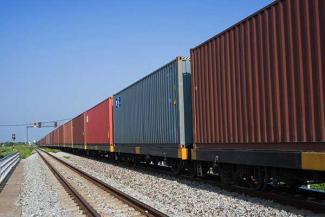Is Intermodal Shipping Right for Your Business?

Intermodal overview: what to expect from this transportation mode
If you’re looking for extra capacity in a tight freight market or exploring cost-saving options for your supply chain, intermodal shipping could be what you need. Anything from electronics to home décor can ship securely via intermodal, and if you have consistent shipments traveling 750 miles or more, it can offer a number of benefits along the way.
How intermodal works
The first step to understanding how intermodal shipping can benefit your business is understanding exactly how it works. Intermodal combines two other modes — truck and rail — to complete a single shipment. It uses a truck for pickup, rail for the long haul, and another truck for delivery.
While it can seem complicated to divide a shipment into three parts, intermodal is no more difficult than booking an over-the-road (OTR) shipment. From start to finish, your freight remains in a single container, and everything gets logged under a single bill of lading. Here’s an overview of the intermodal shipping process:
Pickup
Your freight is loaded into either a removable dry trailer or a 53-foot intermodal shipping container, where it stays for its whole journey. It’s then delivered to the rail yard.
Long haul
At the rail yard, freight is loaded onto a train by one of two methods:
-
Trailer on a flatcar (TOFC), where the entire trailer, wheels and all, is loaded onto a train car
-
Container on a flatcar (COFC) where the container is lifted from the truck’s flatbed and placed on the train car
Once loaded, the shipment completes the long-haul portion of the route. Since there is no single rail system that can deliver to every destination, freight may sometimes need to be interlined between different rail systems. Your freight stays securely in its shipping container or trailer as it switches rail lines.
Delivery
Once the freight completes the rail leg of the journey, it’s picked up by another truck and delivered to its final destination.
How intermodal works for you
Intermodal’s use of trains isn’t the only thing that makes it a unique shipping option — it can also make your supply chain cheaper, more predictable, and more energy efficient than shipping over-the-road. If you’re still unsure if intermodal is right for you, here are some of the major benefits to help you decide:
Reduces handling
Once your freight is loaded into a trailer or shipping container, it stays there for the whole journey. Avoiding extra handling can help protect sensitive freight from potential damage.
Increases capacity options
In cases where LTL may not be most cost- or time-effective and truckload capacity may be too tight, intermodal can offer an alternative option to keep your freight on schedule.
Provides consistent, economical rates
Since a train carries the longest portion of an intermodal shipment, rail prices have the biggest impact on rates. Although this can change based on demand and season, rail usually has more predictable pricing and better value compared to OTR shipping. This is because there is typically plenty of rail capacity and freight trains are cheaper to fuel than other equipment options. This means quotes are likely to stay consistent from day to day and even from week to week, which makes it easier to budget your transportation costs.
Ships with the environment in mind
A freight train can haul one ton of freight an average of 470 miles with just a single gallon of fuel — making it one of the most efficient modes of transportation. So, if you’re looking to create a greener supply chain, intermodal can help you do exactly that. Reducing your emissions can both shrink your carbon footprint and improve relationships with customers who are looking for environmentally conscious business partners.
Lessens risk of delay
Where OTR shipping is affected by traffic, construction and road hazards, intermodal is less vulnerable to these types of delays. Instead, intermodal stays on track and gives you more predictable delivery times.
Gain rail capacity and savings with ArcBest intermodal
With over 90 years of logistics experience and relationships with all seven Class I railroads, ArcBest can get your freight on the tracks with ease and efficiency. Learn more about how ArcBest’s intermodal solution can meet your needs.

